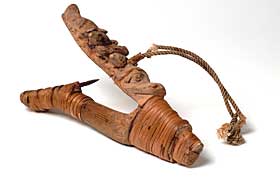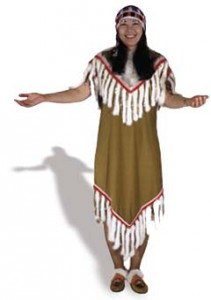Looking Both Ways is an online, interactive exhibit about the Alutiiq People of Southern Alaska, created by the Smithsonian Arctic Studies Center, the Alutiiq Museum and Archaeological Repository and the Alaska Native Heritage Center. The names of these three institutions are displayed largely on the homepage, indicating the collaborative nature of the project.
The exhibit provides a brief introduction to the region and people and map, which you can click on to learn about each village. Each village has about five photographs from different time periods with descriptions that name specific individuals and locations. The exhibit also has a section entitled “Object Categories,” which is comprised of different pages, such as “Our Ancestors,” or “Our Beliefs,” that use archaeological artifacts to tell the story of their way of life and show their evolution from the time of their ancestors through the present. These materials are, however, completely removed from their context, photographe d against a white background, and the descriptions rarely tell you from which site they were found, which village they belonged to, what they meant to their owners or how they were found. Furthermore, images under the “Our Way of Living” section are given no dates, and are photographed as if primitive tools, no longer in use, but they sill allow the viewer to associate them with contemporary Alutiiq life. (see right)
d against a white background, and the descriptions rarely tell you from which site they were found, which village they belonged to, what they meant to their owners or how they were found. Furthermore, images under the “Our Way of Living” section are given no dates, and are photographed as if primitive tools, no longer in use, but they sill allow the viewer to associate them with contemporary Alutiiq life. (see right)
I think the main idea of the site is to attempt tell the story of the Alutiiq people from their perspective, and teach the public about their heritage and identity. However, the exhibition focuses primarily based on the incontrovertible evidence of archaeological material to build their story, rather than through the multiple perspectives of oral histories, and in doing so loses any sense of indigenous authorship, despite its alleged collaboration. Whether the individual tribes where a part of the process, remains unclear.
While there are a lot of good ideas in this site, and it is very engaging, in some areas I believe is misuses images, as Perry  warns us in her article. Some of the pictures are so obviously staged that they seem a bit phony, more like Halloween costume advertisements than images of real contemporary people, as they are completely removed from any sort of context (see left). Images such as these perpetuate stereotypes, and do not enable the viewer to create this new, factual-based conception of modern and historical indigenous life that the site aims to depict.
warns us in her article. Some of the pictures are so obviously staged that they seem a bit phony, more like Halloween costume advertisements than images of real contemporary people, as they are completely removed from any sort of context (see left). Images such as these perpetuate stereotypes, and do not enable the viewer to create this new, factual-based conception of modern and historical indigenous life that the site aims to depict.
